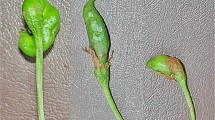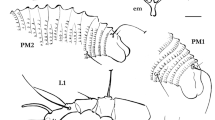Abstract
Anguina obesa n. sp., a new species of the genus, causing small seed galls inside the ovaries of foxtail weed plants (Alopecurus mysuroides Huds.) is described and illustrated based on its morphological and molecular characters. The new species is characterized by its 1516–2564 μm long obese females irregularly ventrally curved after fixation, having six lines in lateral fields, 6–9 μm long stylet with well-developed rounded knobs, constriction at junction of isthmus with the pharyngeal bulb, monodelphic-prodelphic female reproductive system, and conical, 60–80 μm long tail. Males of the new species are characterized with their slender 936–1420 μm long body, 25–30 μm long tylenchoid spicules, and bursa not reaching tail tip. Second stage juveniles of the new species were also common inside the galls and also recovered from soil in type locality. The new species is morphologically close to Anguina agropyronifloris, A. amsinckiae, A. paludicola and A. tumefaciens, but is more closely related to A. paludicola, from which it can be separated based on differences in morphological characters and internal transcribed spacer sequence. In Bayesian inference using sequences of the aforementioned genomic fragment, the new species formed a clade with A. agrostis, A. funesta, A. graminis, A. phalaridis and some unidentified isolates, with robust Bayesian posterior probability (BPP). The morphologically closest species, A. paludicola, occupied a separate position, outside of the clade containing the new species. The sequences of two other genomic fragments, 18S and 28S rDNA (D2/D3 region) were also made available for the new species. Morphological comparisons of the new species with the related species are discussed.





Similar content being viewed by others
Change history
09 March 2018
In the original version of this article, the name of host plant Alopecurus myosuroides was incorrectly written as Alopecurus mysuroides.
References
Andrássy, I. (2007). Free-living nematodes of Hungary. Journal Pedozoologica Hungarica No.4. Hungarian Natural History Museum, 496 pp.
Bertozzi, T. (2003). Biology and control of the Anguinid nematode associated with flood plain staggers. Ph.D. thesis, Adelaide: University of Adelaide.
Bertozzi, T., & Davies, K. (2009). Anguina paludicola sp. n. (Tylenchida: Anguinidae): The nematode associated with Rathayibacter toxicus infection in Polypogon monspeliensis and Lachnagrostis filiformis in Australia Zootaxa, 2060, 33-46.
Castresana, J. (2000). Selection of conserved blocks from multiple alignments for their use in phylogenetic analysis. Molecular Biology and Evolution, 17(4), 540–552.
Cobb, N. A. (1932). Nematosis of a grass of the genus Cyanodon [= Cynodon] caused by a new nema of the genus Tylenchus Bast. Journal of the Washington Academy of Sciences, 22(9), 243-245.
Chizhov, V. N. (1980). Taxonomic status of some species of Anguina Scopoli, 1777. Byull. Vses. Inst. Gel’mintol. K.I. Skrjabina (Fitogel’mintologiya), 26, 83–95 (In Russian.).
Chizhov, V. N., & Subbotin, S. A. (1985). A revision of nematodes of the subfamily Anguininae (Nematoda, Tylenchida) on the basis of their biological peculiarities. Zoologicheskii Zhurnal, 64, 1476–1486 (In Russian.).
Dahiya, R. S., & Bhatti, D. S. (1980). Incidence of tundu on weed plant. Haryana Agricultural University Journal of Research, 10, 257.
De Grisse, A. T. (1969). Redescription ou modifications de quelques techniques utilisées dans l’étude des nematodes phytoparasitaires. Mededelingen Faculteit Landbouwwetenschappen Rijksuniversiteit Gent, 34, 351–369.
Dorris, M., Viney, M. E., & Blaxter, M. L. (2002). Molecular phylogenetic analysis of the genus Strongyloides and related nematodes. International Journal for Parasitology, 32(12), 1507–1517.
Drummond, A. J., & Rambaut, A. (2007). BEAST: Bayesian evolutionary analysis by sampling trees. BMC Evolutionary Biology, 7(1), 1.
Edgar, R. C. (2004). MUSCLE: multiple sequence alignment with high accuracy and high throughput. Nucleic Acids Research, 32(5), 1792–1797.
Filipjev, I. N. (1936). On the classification of the Tylenchinae. Proceeding of Helminthological Society of Washington, 3, 80–82.
Filipjev, I. N., & Schuurmans Stekhoven Jr., J. H. (1941). A manual of agricultural helminthology. Leiden: E.J. Brill 878 pp.
Fleming, A. J., Wood, D. M., Janzen, D., Hallwachs, W., & Smith, M. A. (2015). Seven new species of Spathidexia Townsend (Diptera: Tachinidae) reared from caterpillars in area de Conservación Guanacaste, Costa Rica. Biodiversity data journal, 3, e4597.
Ghaderi, R., Kashi, L., & Karegar, A. (2012). The nematodes of Iran, based on the published reports until 2011. Tehran: Education and Agricultural Promotion Publisher 379 pp. ISBN: 9786006362229.
Hardy, J. (1850). On the effects produced by some insects, etc., upon plants. Annual Magazine of Natural History, 6(2), 182–188.
Huson, D. H., & Scornavacca, C. (2012). Dendroscope 3: an interactive tool for rooted phylogenetic trees and networks. Systematic Biology, 61(6), 1061–1067.
Kühn, J. (1857). Über das Vorkommen von Anguillulen in erkrankten Bluhtenkopfen von Dipsacus fullonum L. Z. Zeitschrift für wissenschaftliche Zoologie, 9, 129–137.
Larget, B., & Simon, D. L. (1999). Markov chain Monte Carlo algorithms for the Bayesian analysis of phylogenetic trees. Molecular Biology and Evolution, 16, 750–759.
McClure, M., Schmitt, M. E., & McCullouch, M. D. (2008). Distribution, biology and pathology of Anguina pacificae. Journal of Nematology, 40, 226–239.
Nicoll, W. (1935). Rhabditida. Anguinidae. VI. Vermes. Zoological Record, 72, 105.
Norton, D. C. (1965). Anguina agropyronifloris n. sp., infecting florets of Agropyron smithii. Proceedings of Hehninthological Society of Washington, 32, 118–122.
Nunn, G. B. (1992). Nematode molecular evolution. An investigation of evolutionary patterns among nematodes based on DNA sequences. Nottingham: University of Nottingham.
Nylander, J. A. A. (2004). MrModeltest v2. Program distributed by the author. Uppsala University, Evolutionary Biology Centre.
Nylander, J. A. A., Wilgenbusch, J. C., Warren, D. L., & Swofford, D. L. (2008). AWTY (are we there yet?): A system for graphical exploration of MCMC convergence in Bayesian phylogenetics. Bioinformatics, 24, 581–583.
Pantone, D. J., Griesbach, J. A., & Maggenti, A. R. (1987). Morphometric analysis of Anguina amsinckiae from three host species. Journal of Nematology, 19(2), 158.
Paramonov, A. A. (1967). A critical review of the suborder Tylenchina (Filipjev, 1934) (Nematoda: Secernentea). Akademii Nauk SSSR Trudy Gel’mint. Lab, 18, 78–101. (In Russian.)
Paramonov, A. A. (1970). Principles of Phytonematology. Vol. III. Taxonomy of Nematodes of the Superfamily Tylenchoidea. Izdatelstvo ‘Nauka’, Moscow, 253 pp. (In Russian.) English translation available from US Department Committe National Technical Information Service, Springfield, USA, 200 pp.
Powers, T. O., Szalanski, A. L., Mullin, P. G., Harris, T. S., Bertozzi, T., & Griesbach, J. A. (2001). Identification of seed gall nematodes of agronomic and regulatory concern with PCR-RFLP of ITS1. Journal of Nematology, 33(4), 191.
Price, P. C., Fisher, J. M., & Kerr, A. (1979). On Anguina funesta n. sp. and its association with Corynebacterium sp., in infecting Lolium rigidum. Nematologica, 25(1), 76–85.
Ronquist, F., & Huelsenbeck, J. P. (2003). MrBAYES 3: Bayesian phylogenetic inference under mixed models. Bioinformatics, 19, 1572–1574.
Scopoli, G. A. (1777). Introductio ad historiam naturalem sistens genera lapidum, plantarum et animalium hactenus detecta, caracteribus essentialibus donata, in tribus divisa, subinde ad leges naturae. Prague, 506 pp.
Siddiqi, M. R. (2000). Tylenchida: parasites of plants and insects (2nd ed.). Wallingford: CABI Publishing 833 pp.
Silvestro, D., & Michalak, I. (2012). RaxmlGUI: a graphical front-end for RAxML. Organisms Diversity & Evolution, 12, 335–337.
Soleymanzadeh, M., Pedram, M., Pourjam, E. & Álvarez-Ortega, S. (2016). Description of Lelenchus brevislitus n. sp. (Nematoda: Tylenchidae), an example of a cryptic species from Iran and its phylogenetic relationships with other species in the family. Nematology, 18, 987–998..
Steinbuch, J. G. (1799). Das Grasalchen, Vibrio agrostis. Naturforscher, 28, 233–259.
Steiner, G., & Scott, C. E. (1935). A nematosis of Amsinckia caused by a new variety of Anguillulina dipsaci. Journal of Agriculture Research, 49, 1087–1092.
Subbotin, S. A., & Riley, I. T. (2012). Stem and gall forming nematodes. In Book: Practical Plant Nematology.
Subbotin, S. A., Krall, E. L., Riley, I. T., Chizhov, V. N., Staelens, A., De Loose, M., & Moens, M. (2004). Evolution of the gall-forming plant parasitic nematodes (Tylenchida: Anguinidae) and their relationships with hosts as inferred from internal transcribed spacer sequences of nuclear ribosomal DNA. Molecular Phylogenetics and Evolution, 30(1), 226–235.
Swart, A., Subbotin, S. A., Tiedt, L. R., & Riley, I. T. (2004). Anguina woodi sp. n. (Tylenchida: Anguinidae) from dune grass, Ehrharta villosa, in South Africa. Nematology, 6(1), 129–144.
Tamura, K., Stecher, G., Peterson, D., Filipski, A., & Kumar, S. (2013). MEGA6: molecular evolutionary genetics analysis version 6.0. Molecular Biology and Evolution, 30(12), 2725–2729.
Thorne, G. (1961). Principles of nematology. New York: McGraw-Hill Book Co., Inc. xiv + 553 pp.
Van den Berg, E. (1985). Notes on the genus Afrina brzeski, 1981 (Anguinidae: Nematoda) with descriptions of new and known species. Phytophylactica, 17, 67–79.
Vera, I. C. D. P., & Maggenti, A. R. (1984). A new gall-forming species of Anguina Scopoli, 1777 (Nemata: Anguinidae) on bluegrass, Poa annua L., from the coast of California. Journal of Nematology, 16(4), 386.
Vovlas, N., Subbotin, S. A., Troccoli, A., Liébanas, G., & Castillo, P. (2008). Molecular phylogeny of the genus Rotylenchus (Nematoda, Tylenchida) and description of a new species. Zoologica Scripta, 37(5), 521–537.
Vovlas, N., Troccoli, A., Palomares-Rius, J. E., De Luca, F., Liébanas, G., Landa, B. B., Subbotin, S. A., & Castillo, P. (2011). Ditylenchus gigas n. sp. parasitizing broad bean: a new stem nematode singled out from the “Ditylenchus dipsaci species complex” based on polyphasic identification and molecular phylogeny. Plant Pathology, 60, 762–775.
Vrain, T. C., Wakarchuk, D. A., Levesque, A. C., & Hamilton, R. I. (1992). Intraspecific rDNA restriction fragment length polymorphism in the Xiphinema americanum group. Fundamental and Applied Nematology, 15(6), 563–573.
Whitehead, A. G., & Hemming, J. R. (1965). A comparison of some quantitative methods of extracting small vermiform nematodes from soil. Annals of Applied Biology, 55(1), 25–38.
Williams, B. D., Schrank, B., Huynh, C., Shownkeen, R., & Waterston, R. H. (1992). A genetic mapping system in Caenorhabditis elegans based on polymorphic sequence-tagged sites. Genetics, 131, 609–624.
Acknowledgements
We appreciate the kind help of Dr. Ian Riley and Dr. Vladimir N. Chizhov, especially for making data available for some species of Anguina, and Prof. Valiollah Mozaffarian from Research Institute of Forests and Rangelands for his help with identifying of the host plant of the new species. The financial supports of Iranian National Science Foundation (INSF) and Tarbiat Modares University is appreciated.
Author information
Authors and Affiliations
Corresponding author
Additional information
A correction to this article is available online at https://doi.org/10.1007/s10658-018-1450-7.
Rights and permissions
About this article
Cite this article
Mobasseri, M., Pedram, M., Pourjam, E. et al. Description of a new species of seed-gall nematode, Anguina obesa n. sp. (Nematoda: Anguinidae) from northern Iran, and its phylogenetic relations with other species and genera. Eur J Plant Pathol 148, 423–434 (2017). https://doi.org/10.1007/s10658-016-1101-9
Accepted:
Published:
Issue Date:
DOI: https://doi.org/10.1007/s10658-016-1101-9




